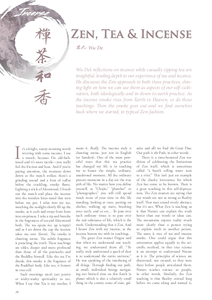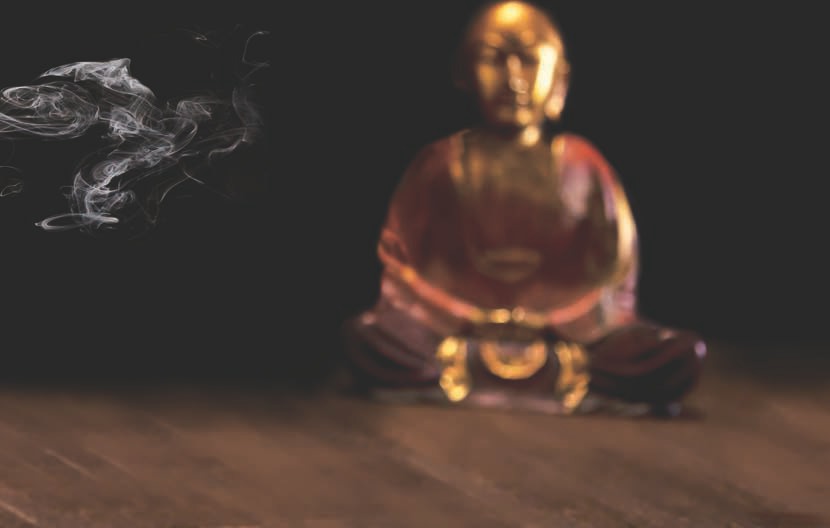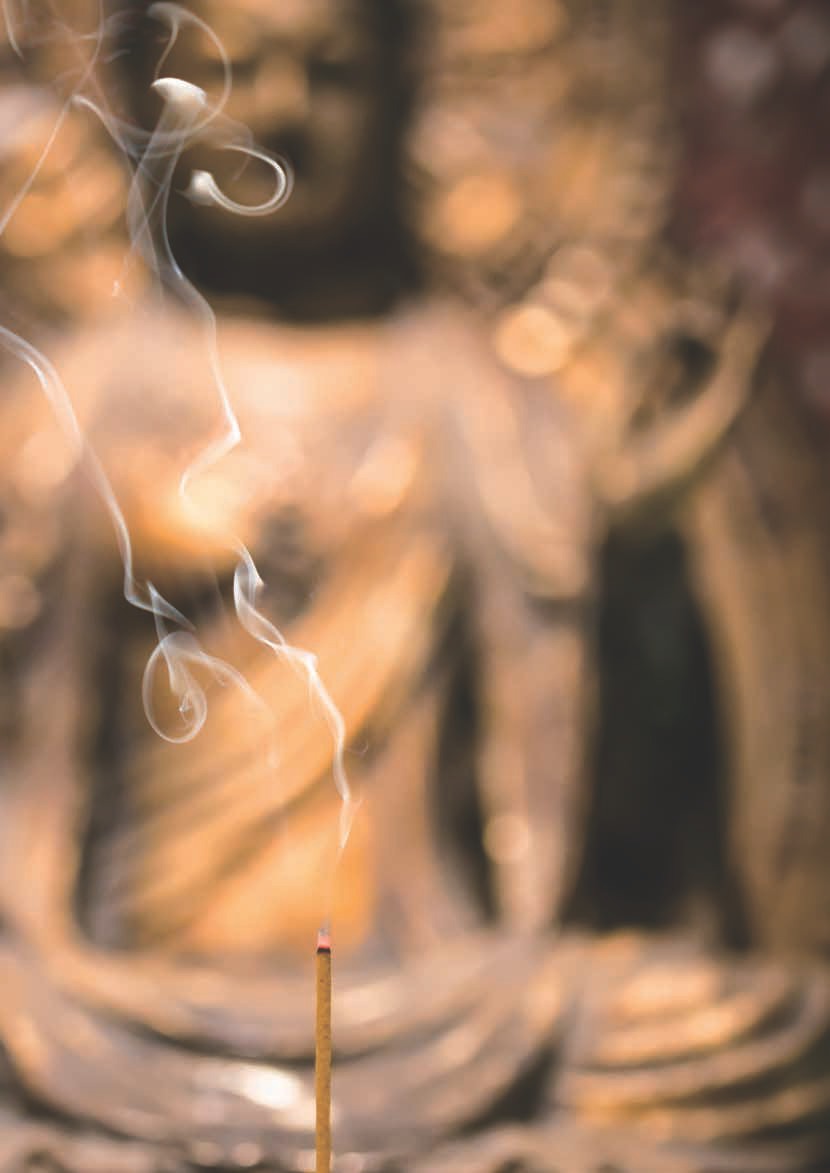
 |
|

It's a bright, sunny morning worth revering with some incense. I use a match, because I'm old-fashioned and it's more tactile - you really feel the friction and heat. And if you're paying attention, the moment slows down as the match strikes; there's a grinding sound and a hint of sulfur before the crackling, smoky flame. Lighting a stick of Aloeswood, I brush out the match and place the incense into the wooden lotus-stand that rests before my pot. I relax into my tea, watching the sunlight slowly fill up the smoke, as it curls and sways from form into emptiness. I take a sip and breathe in the fragrances of tea and Aloeswood both. The tea opens me up (empty) and as I set down the cup the incense takes me over (form). The smoke is chanting sutras. The subtle fragrance is preaching the truth. These teachings are older, deeper and more profound than those of all the patriarchs and the Buddha himself. Like the tea I've drunk, this smoke is the fragrance of the Buddha's body. Like me, it honors its true self.
Such mornings aren't just poetry or wishy-washy spirituality to me. When I say that Tea is my teacher, I mean it. Really. The incense truly is chanting sutras, just not in English (or Sanskrit). One of the most powerful ways that this tea practice has changed my life is in teaching me to honor the simple, ordinary, unadorned moment. All the ordinary present moments in a day are the true pith of life. No matter how you define yourself, as "Chajin," "plumber" or "photographer," you will still spend much more of your time in this life standing, looking at trees, putting on clothes, walking up stairs, brushing your teeth, and so on... To pass over such ordinary times is to pass over the real substance of life, which is the truth. Understanding that is Zen. And I honor Zen with my incense, as the incense honors me with its teachings.
The great Zen master Dogen said that when we understand one teaching, we understand them all. "To really, truly understand a speck of dust is to understand the entire universe." He was speaking of the interbeing of all things. Through finding our path, as small, individual beings navigating our limited time on this Earth (a planet which is also a relatively small thing in the cosmic sense of stars, galaxies and all) we find the Great Dao. Our path is the Path, in other words.
There is a time-honored Zen tradition of celebrating the limitations of Zen itself, which is sometimes called "a booth selling water next to a river." This isn't just an example of the cheeky irreverence for which Zen has come to be known. There is a great teaching in this self-deprecation. The Zen masters are saying that our words are not as strong as Reality itself. That may sound overly abstract, but it's not. What Zen is teaching us is that Nature can explain the truth better than our words or ideas can. The mountains express reality much more clearly than a person trying to explain truth to another person. The same is true of tea and incense smoke. One could argue that this orientation applies equally to the scientific method, in that true science is an attempt to understand Nature as it is. The principles of science are discovered, not created, so they were there before people articulated them. Nature teaches science to people, in other words. Similarly, the Zen teaching is that Reality existed long before we came along and named it, and will do so long after we are gone (in fact, long after our sun itself has died). And our concepts, as well as the words we use to convey them, will always be very pale in comparison to the truth, just as a description of a sunset over a mountain range, no matter how poetic, will never compare to actually being a part of that experience; just like incense smoke is the moment and no words could ever encapsulate, let alone enhance, its fragrance, or the beauty of the play between the sunlight and the curly puffs of smoke.
Because Zen is saying that Nature is a better teacher than a person doesn't mean, as some misunderstand, that Zen is saying we throw out words, ideas or teachings. We are communicating through words and ideas now - me in the writing and you in the reading. Truth is captured and conveyed in words, ideas and logic as well, but often not as powerfully or directly as a cup of tea, a mountain or a river. And since words and ideas can also block our intuition - our inherent connection to Nature - it is often an illogical, nonverbal communication that wakes us up in the end.

The most famous of all Chinese poets, Su Dongpo (1036 - 1101 C.E.), was a Zen Buddhist. His master Donglin Changzhong (1025 - 1091 C.E.) taught Su that the "preaching of the Buddha didn't start with the Buddha and didn't stop with his death." Many years later, as Su sat up meditating through the night, he listened to the river and finally, after years of contemplation, understood what his master meant. He composed this poem, which his master later acknowledged:
The voices of the valley are the Buddha's words The mountains naught but his pure body Throughout the long night, A thousand verses are chanted, What can I say about this that isn't shoddy?
All throughout the annals of Zen, there are hundreds of enlightenment stories in which a monk or nun, after some time meditating, realizes the truth by seeing a flower, hearing a natural sound, stubbing a toe on a rock or looking out on a mountain vista. Xiangyan Zhixian (d. 898 C.E.), for example, was enlightened by seeing a blossom fall, whereupon he exclaimed in poetry that he had been looking for the right "sword" his whole life, which means intellectual approach (the sword cuts and divides, and so is a symbol for the mind), while blossoms had been falling the whole time and he hadn't really, truly seen a single one. He then remembered that he had once asked his teacher to explain the truth and his master had said that he could indeed explain things for hours and hours, but that Xiangyan would later thank him for not doing so, since all those concepts would only get in the way. Remembering this, he bowed in the direction of his teacher, fully grateful just as his master said he would be.
The Japanese Zen master Enni Ben'en expressed this teaching quite aptly, saying, "The knowledge that one attains through learning the sutras and commentaries is called seeing, hearing, perceiving and understanding. This is the knowledge of simple, ignorant people; it is not true understanding. The one who directs the light and allows the light to reflect back, such a one grasps the original Buddha nature. This is what is called the 'Eye of Wisdom.' With this eye one sees one's nature and becomes Buddha." It is one thing to understand intellectually, but another altogether to be this moment. And that is the practice of the Way of Tea, and of incense as well. We are connecting to the teachings of Nature through the tea and the smoke, absorbing those teachings and reflecting them back, so that we are a part of the sermons that the mountains and rivers are chanting through the smoke as it rises, plays with the light and then walks out the door of form - back to the emptiness whence it came.

This orientation/attitude is the Zen mind. The etymology of the Japanese word "Zen" demonstrates this, as it can be traced to a southern pronunciation of the Chinese word "Chan (禪)," which is in turn derived from the Sanskrit "Dhyana," meaning "the meditative mind." This mind, or attitude, is the essence of Zen. And that orientation is what is being referred to in the age-old expression that "Zen and Tea are one flavor." The heart-mind oriented beyond words to Nature, and a communion with its teachings, is what aligns Zen and Tea, not the Buddhist religious practices that orbit the Zen heart-mind.
Dogen-Zenji said that this attitude was Buddhism, and Buddhism nothing more than this attitude. It is an attitude of listening and honoring - of being a student, surrendering to the moment and to what is true and real in this instant of happening. This is the real function of a Zen and Tea practice: to cultivate the "Eye of Wisdom" - to see into one's nature as it is. This is called "kensho" in Japanese (literally, "seeing one's true nature), or sometimes "kenshin," which means "seeing one's true heart." And this "seeing" into nature isn't with the eyes; it streams in through all our senses. You could say it is an orientation towards apprehending nature clearly with a human body. And words can only describe that if the words and impressions themselves are the focus of presence. Otherwise, this is just a philosophy.
These ideas therefore need to be applied as a real attitude, in the practicalities of our daily life. We really have to see, in other words, or we're left asking what this attitude has to do with our own lives as they are happening day in and day out. What do these grandiose ideas have to do with a real tea practice? With incense? What does this orientation really have to do with the realities of steeping tea, pouring it and serving it to others? It sounds nice to speak of "Great Nature," but what does that really have to do with me as I stare down at this cup of oolong before me?
The most essential way that our tea practice can embody kensho is to see Tea as our teacher, which is to say that Nature is our teacher (which it ever and always is). In the same way that we listen to Nature, as its teachings are more concrete and real than anything we come up with to describe them, and then try to live those teachings - in the same way, we must listen to the tea and prepare it in the way it "wants" to be prepared. Listening to the tea and adapting one's brewing to suit this very pot is following the Dao because it is following the moment - the nature of the tea itself (and not as a genre, or even tea from such and such a farm, but this very steeping in the concrete) - harmonizing the micro and macro together in fused alchemy. By focusing on and truly understanding the minutiae of tea, we are realizing the universal. The details of this moment are more real than any abstractions, even insightful ones. In our cup there is water, mountain, wind and fire, and there is also our own mind and Buddha's mind.
This practice of seeing the large in the small has ever and always informed Eastern art, from painting to bonsai. Scholars and artists here have always longed to find a window through their art to Great Nature, "touching" it, as you say in Chinese (聯繫大自然). They sought this communion through the discipline and practice of the art itself, and also hoped to convey that heart/orientation/Nature enough in their work that others (including their own future selves) could also find Great Nature through observing their works. There are several old Chinese stories that exemplify this: a master meditates on a masterpiece of painting long enough - staring into the cliffs and crags of the landscape until he sees Great Nature through the transparency of the artist's heart, which is also Nature - until he eventually disappears. Later, his loved ones then report seeing the sage in various places in the painting: dangling his legs from this cliff one day and drinking tea on that ledge on another day.
This is why we focus on all the myriad details that go into a chaxi. When some interviewers for a film asked me why I bothered to hike up into the mountains to collect water every week, I looked around at the distant mountains and realized, right there in that moment on film, that the hike into the mountains every week over the years had changed me as much as it had the tea I prepare. It wasn't just about better water for tea; it was about more of myself in the tea practice, which means more of the tea practice in me. The same is true of all else: using carefully-laid charcoal, learning to select the right teaware, practicing and improving one's ability to pour, arranging decorations and also incense. Like the master who became the painting, it's as if I disappeared after enough cups, and you noticed my rough shape in the steam billowing from a freshly-showered pot or dancing with the leaf bits at the bottom of a cup.
Every aspect of the tea ceremony is this here/now - this moment in space/time - teaching us. It is singing the oldest sutras there are. It is life itself. It is the truth of a universe that does actually exist and we are it and seeing it at the same time - a moon to the sun of its awakening. Tea is teaching us of the starshine and sunshine photosynthesized in these leaves, the water, which was in a cloud less than two weeks ago, the mountain and minerals the tree drank, the coals which are the heat of our sun, the water we gathered on hikes and the incense smoke gathering light and swaying to and from emptiness. All of this makes the ceremony an expression of Nature. And if we can hear those teachings and live them in the moment, we will be oriented towards truth. As Master Enni said, we will be gathering the light of the world and reflecting it back.
Dogen said that we should be eternally grateful for the conditions that came together which allow us to hear the "mountains and rivers sutra," and there are so many: We have these bodies, gifted to us by our parents and ancestors, who suffered through wars and droughts to give us life. And we have the "Treasury of the True Dharma Eye" which allows us to recognize that Nature is always talking to us. And, of course, we have Tea, who helps us understand what Nature is saying. We even have this Hut to be grateful for, as sharing these understandings with others is a big part of what makes them possible in the first place! I love you. I hope you know that. This incense is to honor you as well.
This month, as you sip fine oolong and watch incense smoke trail into nothingness, gathering the light before it goes, try to listen and honor a bit more. Our ancestors have used incense to honor for millennia. Incense makes a wonderful offering. Try to hear the moment - to gather its light and reflect it back on the world. And then fill your heart with gratitude for Tea and for each other...

